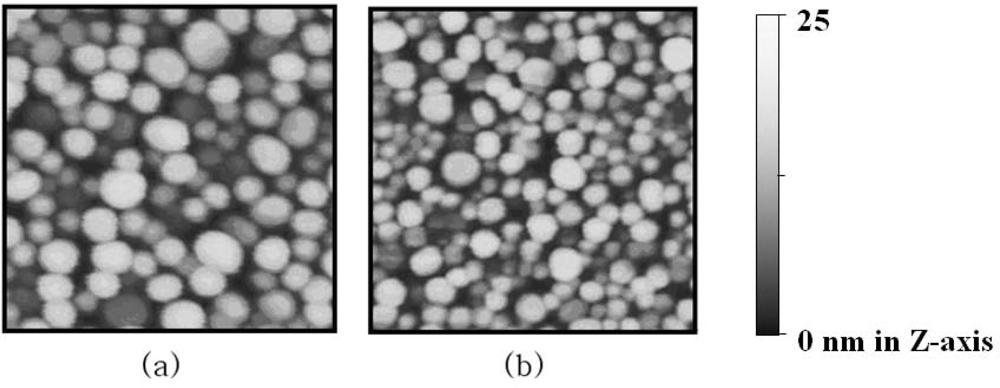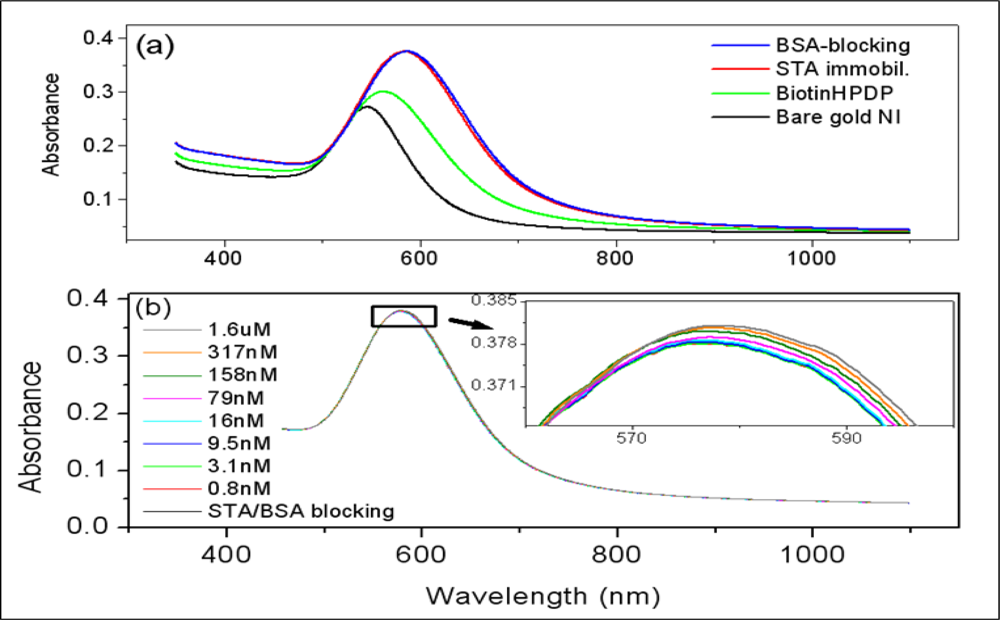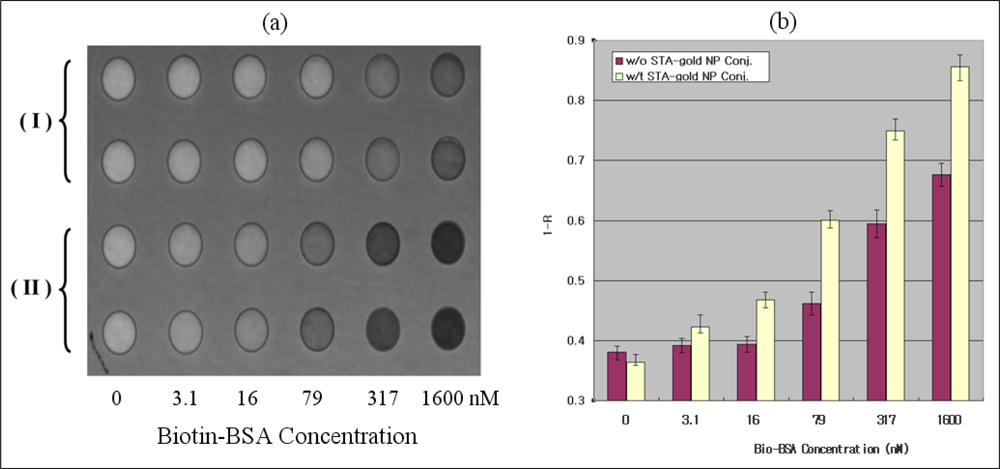Detection of Biomolecular Binding Through Enhancement of Localized Surface Plasmon Resonance (LSPR) by Gold Nanoparticles
Abstract
:1. Introduction
2. Results and Discussion
2.1. Affinity-based bioassay with normal transmission measurements using gold NI chip
2.1. ATR image measurement for the detection of multiple species using gold NI well chip
3. Experimental Section
3.1. Formation of gold nano-island(NI) films on glass substrates
3.2. Modifications of gold NI surfaces and bindings of Bio-BSA with gold NI surfaces
3.3. Synthesis of STA-gold NP conjugates for enhancement of the LSPR signals
3.4. Measurements of LSP bands and surface morphologies
3.5. Fabrication of gold NI well chip and measurements of affinity bindings to the gold NI well chips using the ATR mode
4. Conclusions
Acknowledgments
References
- Kretschmann, E. Die bestimmung optischer konstanten von metallen durch anregung von oberflächenplasmaschwingungen. Z. Phys. A 1971, 241, 313–324. [Google Scholar]
- Gluodenis, M.; Manley, C.; Foss, C.A. In situ monitoring of the change in extinction of stabilized nanoscopic gold particles in contact with aqueous phenol solutions. Anal. Chem 1999, 71, 4554–4558. [Google Scholar]
- Malinsky, M.D.; Kelly, K.L.; Schatz, G.C.; Van Duyne, R.P. Chain length dependence and sensing capabilities of the localized surface plasmon resonance of silver nanoparticles chemically modified with alkanethiol self-assembled monolayers. J. Am. Chem. Soc 2001, 123, 1471–1482. [Google Scholar]
- Nath, N.; Chilkoti, A. A colorimetric gold nanoparticle sensor to interrogate biomolecular interactions in real time on surface. Anal. Chem 2002, 74, 504–509. [Google Scholar]
- Frederix, F.; Friedt, J.; Choi, K.; Laureyn, W.; Campitelli, A.; Mondelaers, D.; Maes, G.; Borghs, G. Biosensing based on light absorption of nanoscaled gold and silver particles. Anal. Chem 2003, 75, 6894–6900. [Google Scholar]
- Lahav, M.; Vaskevich, A.; Rubinstein, I. Biological sensing using transmission surface plasmon resonance spectroscopy. Langmuir 2004, 20, 7365–7367. [Google Scholar]
- Shin, Y.; Lee, J.; Park, M.; Kim, M.; Chung, B.H.; Pyo, H.; Maeng, M. Analysis of recombinant protein expression using localized surface plasmon resonance (LSPR). Biosens. Bioelectron 2007, 22, 2301–2307. [Google Scholar]
- Hiep, H.M.; Endo, T.; Saito, M.; Chikae, M.; Kim, D.K.; Yamamura, S.; Takamura, Y.; Tamiya, E. Label-free detection of melittin binding to a membrane using electrochemical localized surface plasmon resonance. Anal. Chem 2008, 80, 1859–1864. [Google Scholar]
- Doron-Mor, I.; Barkay, Z.; Filip-Granit, N.; Vaskevich, A.; Rubinstein, I. Ultrathin gold island films on silanized glass. Morphology and optical properties. Chem. Mater 2004, 16, 3476–3483. [Google Scholar]
- Kalyuzhny, G.; Vaskevich, A.; Schneeweiss, M.A.; Rubinstein, I. Transmission surface plasmon resonance (T-SPR) measurements for monitoring adsorption on ultrathin gold island films. Chem. Eur. J 2002, 8, 3849–3857. [Google Scholar]
- Nath, N.; Chilkoti, A. Label-free biosensing by surface plasmon resonance of nanoparticles on glass: optimization of nanoparticle size. Anal. Chem 2004, 76, 5370–5378. [Google Scholar]
- Haynes, C.L.; McFarland, A.D.; Zhao, L.; Van Duyne, R.P.; Schatz, G.C. Nanoparticle Optics: The importance of radiative dipole coupling in two-dimensional nanoparticle arrays. J. Phys. Chem. B 2003, 107, 7337–7342. [Google Scholar]
- Raether, H. Surface plasmons on smooth and rough surfaces and on gratings; Springer-Verlag: Berlin Heidelberg, Germany, 1988. [Google Scholar]
- Homola, J.; Yee, S.S.; Gauglitz, G. Surface plasmon resonance sensors: review. Sens. Actuat. B 1999, 54, 3–15. [Google Scholar]
- Hanarp, P.; Käll, M.; Sutherland, D.S. Optical properties of short range ordered arrays of nanometer gold disks prepared by colloidal lithography. J. Phys. Chem. B 2003, 107, 5768–5772. [Google Scholar]
- Yonzon, C.R.; Stuart, D.A.; Zhang, X.; McFarland, A.D.; Haynes, C.L.; van Duyne, R.P. Toward advanced chemical and biological nanosensors-An overview. Talanta 2005, 67, 438–448. [Google Scholar]





© 2009 by the authors; licensee MDPI, Basel, Switzerland This article is an open access article distributed under the terms and conditions of the Creative Commons Attribution license (http://creativecommons.org/licenses/by/3.0/).
Share and Cite
Kim, H.M.; Jin, S.M.; Lee, S.K.; Kim, M.-G.; Shin, Y.-B. Detection of Biomolecular Binding Through Enhancement of Localized Surface Plasmon Resonance (LSPR) by Gold Nanoparticles. Sensors 2009, 9, 2334-2344. https://doi.org/10.3390/s90402334
Kim HM, Jin SM, Lee SK, Kim M-G, Shin Y-B. Detection of Biomolecular Binding Through Enhancement of Localized Surface Plasmon Resonance (LSPR) by Gold Nanoparticles. Sensors. 2009; 9(4):2334-2344. https://doi.org/10.3390/s90402334
Chicago/Turabian StyleKim, Hyung Min, Seung Min Jin, Seok Kee Lee, Min-Gon Kim, and Yong-Beom Shin. 2009. "Detection of Biomolecular Binding Through Enhancement of Localized Surface Plasmon Resonance (LSPR) by Gold Nanoparticles" Sensors 9, no. 4: 2334-2344. https://doi.org/10.3390/s90402334



